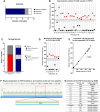FGF14 GAA Intronic Expansion in Unsolved Adult-Onset Ataxia in the Care4Rare Canada Consortium
- PMID: 40191983
- PMCID: PMC12172122
- DOI: 10.1002/acn3.70016
FGF14 GAA Intronic Expansion in Unsolved Adult-Onset Ataxia in the Care4Rare Canada Consortium
Abstract
Background and objectives: Spinocerebellar ataxias (SCA) represent a clinically and genetically heterogeneous group of progressive neurodegenerative diseases with prominent cerebellar atrophy. Recently, a novel pathogenic repeat expansion in intron 1 of FGF14 was identified, causing adult-onset SCA (SCA27B). We aimed to determine the proportion of our unsolved adult-onset ataxia cohort harboring this expansion using several technologies, and to characterize the phenotypic presentation within our population.
Methods: Individuals presenting with adult-onset ataxia (> 30 years old) and negative previous genetic testing were selected from the Care4Rare patient repository. Affected individuals were from all ethnicities, and 90% had a family history suggestive of dominant ataxia, representing 19 of the 23 families included. We used multiple tools (PCR, long-read genome sequencing and optical genome mapping (OGM)) to identify the pathogenic GAA repeat in FGF14.
Results: Of the 23 families included in this study, 65.2% harbored a pathogenic GAA expansion in FGF14. Individuals of French-Canadian descent (FC) represented most of our cohort and had a 64.7% diagnostic yield. Affected individuals presented with gaze-evoked nystagmus, gait ataxia, cerebellar dysarthria, and early episodic features. The GAA expansion in FGF14 was visible by OGM in all individuals tested.
Interpretation: Our diagnostic yield demonstrates this expansion may be the most common cause of adult-onset SCA in dominant families of FC ancestry. Our FC participants have a phenotype distinct from previously published FC patients, with gaze-evoked nystagmus being the most common eye anomaly. From a diagnostic standpoint, the pathogenic GAA repeat can be identified by OGM, but additional tests are required to complement the interpretation.
© 2025 The Author(s). Annals of Clinical and Translational Neurology published by Wiley Periodicals LLC on behalf of American Neurological Association.
Conflict of interest statement
The authors declare no conflicts of interest.
Figures


References
-
- Ruano L., Melo C., Silva M. C., and Coutinho P., “The Global Epidemiology of Hereditary Ataxia and Spastic Paraplegia: A Systematic Review of Prevalence Studies,” Neuroepidemiology 42, no. 3 (2014): 174–183. - PubMed
-
- Durr A., “Autosomal Dominant Cerebellar Ataxias: Polyglutamine Expansions and Beyond,” Lancet Neurology 9 (2010): 885–894. - PubMed
MeSH terms
Substances
Grants and funding
LinkOut - more resources
Full Text Sources
Molecular Biology Databases
Miscellaneous

